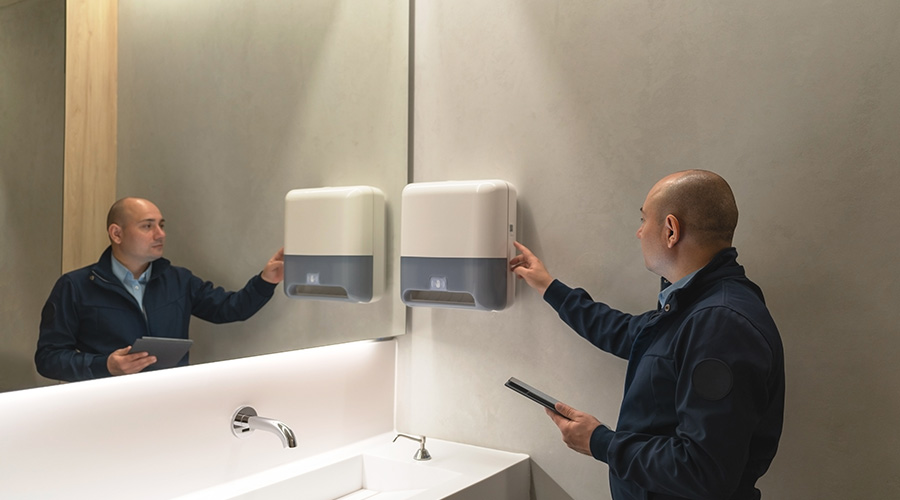Restroom Fixtures, Dispensers Are Common Green Targets
Restrooms have become focal points for many institutional and commercial organizations seeking to become more environmentally responsible. The efforts focus on the specification and maintenance of key elements within restrooms, including plumbing fixtures, paper products, dispensers, and cleaning chemicals.
Since many budgets are tighter and demands for results are louder, managers need to act as quickly as possible to improve the sustainability of restrooms and, at the same time, generate savings for organizations.
By addressing these key product areas and taking steps to improve the productivity of front-line technicians, managers can end up with restrooms that offer both greater sustainability and lower costs.
Piece by Piece
While one or two green initiatives might generate benefits, managers most likely will have to institute a series of changes to produce the desired results. Here are suggested actions related to key restroom products:
Plumbing fixtures. Measure water use for restroom fixtures, and develop a conservation plan. Check for, locate, and fix leaks in faucets, shower heads, and toilet and urinal flush valves.
Also, check for leaks in custodial closet sinks. Water waste might exist where workers store janitorial equipment and supplies and fill cleaning buckets.
Monitor for potential losses by replacing worn O-rings and washers before they start to leak water. This tactic is a proven way to lower water use and waste costs.
Replace older, high-volume, timed-cycle flush valves and high-volume taps with newer, low-flow valves. Make sure sensor valves respond only to appropriate movements and solenoids function properly. Inserting restrictors or replacing valves with return on investment in mind can lock savings into the system.
When upgrading fixtures, convert to fixtures with copper pipe extensions and a brass coupling nut. Technicians can install these extensions more quickly because they do not require a special wrench to reach up under the back of the sink.
Check to see if hot-water temperatures at the heaters are set properly. If the temperature is set at 140 degrees, adjusting it to 120 degrees can result in large electricity savings.
Insulate hot-water lines or move the heater closer to the point of use. This step can minimize heat loss and save water and chemicals.
Put up water-conservation posters that suggest turning off water when shaving, brushing teeth, showering, and bathing.
If the savings related to water, water-softening chemicals, and waste bills in just a few years are greater than the cost of upgrades, the result is a win-win-win situation — free upgrades, a greener facility, and lower operating costs.
Paper products. Verify that paper products deliver the promised sheet count by checking the roll or pack. Use larger sheet-count rolls of toilet paper to cut cost. This step reduces replacement time and empty-dispenser calls. Consider converting to high-velocity air dryers with shorter cycle times in some locations to minimize the use paper towels.
Dispensers. Measure the flow of liquids from dispensers and install restrictors where needed. Use newer dispensers that are easy to refill. Use foam instead of liquid soap to reduce use and pipe clogs. Use cartridge soap replacements to save time reloading dispensers.
Cleaning chemicals. Measure, measure, measure. Many cleaning jobs require only a few ounces of chemical cleaner per gallon of water. If workers pour concentrated cleaner directly into a pail from the bottle, they probably are using too much and forcing the department to pay a premium for chemicals.
This wasteful practice also might create a safety hazard by leaving surfaces slippery after drying. High concentrations of chemicals in the waste water also cause buildup, clogging, and unnecessary loads on waste-treatment facilities.
Related Topics:












